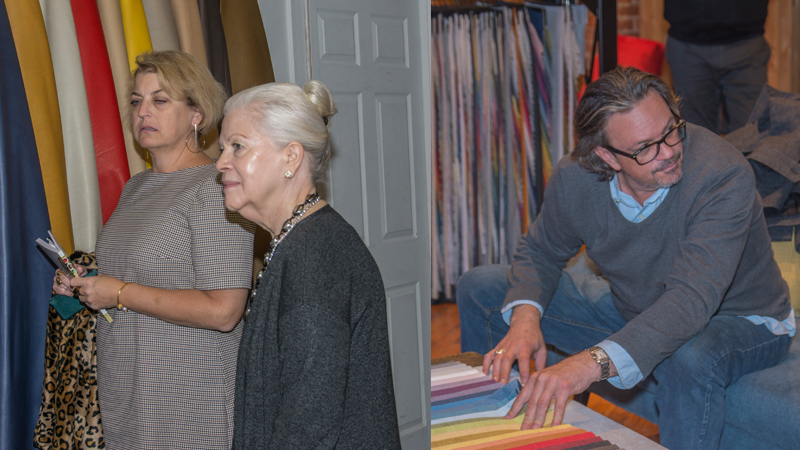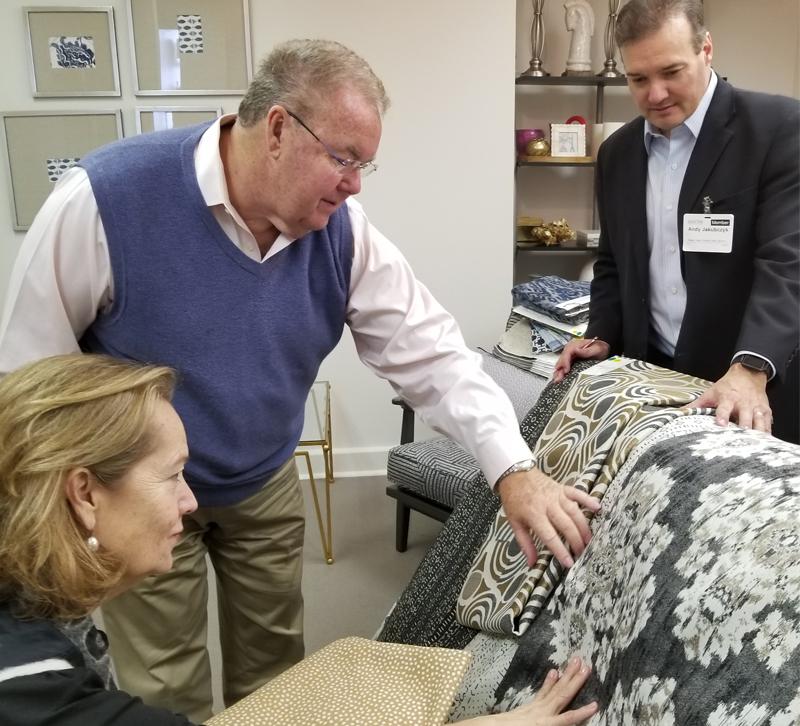It’s only fitting that the newly rebranded International Textile Alliance (ITA), producer of the bi-annual Showtime Market in High Point, NC, has released a new logo and tagline: Connections Happen Here.
Since 1990, Showtime — the largest textile show in North America — has long been known as the market where fabric mills connect with upholstered furniture manufacturers. And it still is. But as the lines between once clear-cut identifications like retailer, manufacturer, supplier, designer, residential, commercial and hospitality continue to blur, the bi-annual fabric fair is fast becoming a connecting point for a melting pot of constituencies…including a growing number of interior designers.
“Historically, you would see two extremes walking the halls at Showtime in terms of retail attendance,” relates Fred Fahrbach, known throughout the industry for his role as the merchandising and product development force behind Spectra Home, a High Point, NC-based stationary upholstered manufacturer with a high-fashion design aesthetic. “There were the big-volume guys like Rooms to Go working the show with their suppliers, and then there were the higher-end specialty stores like Crate & Barrel and Room & Board walking the halls with their vendors in tow. But the middle ground? That was always a big void.”
Not anymore.
While sharp industry observers may have noticed a few savvy interior designers walking the show over the years, “our member companies did not sell directly to interior designers,” says Catherine Morsell, Executive Director of the ITA. “Not only was it much more labor-intensive to handle rolls and cut yardage and therefore not as profitable for the mills, selling direct to the trade was also potentially damaging to the existing relationships that they had with retailers and jobbers. But as the business has changed, and as a lot of interior designers are doing bigger jobs that require rolls versus cut goods, member companies have begun to re-think things. Many are expanding their services and are quite willing to serve the interior design trade. Some will sell cut yardage, and others, even if they can’t sell directly to the designer, are much more open to letting designers review their line at the show before referring them to a jobber that they can do business with.”
Threads Count
Direct access to the mills can be a boon for designers for many reasons, not the least of which are pricing and ease of doing business. Just ask those who have largely purchased fabrics via high-end design center showrooms such as the Atlanta Decorative Arts Center (ADAC) or the Decoration and Design Building (D&D) in New York.
“The fastest and easiest way for me to see the latest fabric collections is to attend Showtime,” says interior and product designer Libby Langdon. “Staying on top of what the newest looks are is imperative for my business and the clients who rely on me to create timeless designs that also incorporate current styles. Fabric is an important tool that helps me achieve that, and Showtime is truly a snapshot of the newest designs and styles all in one place. The fact that it’s one showroom after another of nothing but fabric lets me cover a lot of ground very quickly. For me, it’s much more efficient than making trips to multiple design centers in New York trying to seek out and isolate the new collections,” says the author and makeover television personality.
“Unique at this show, designers can see what is newly launched from ‘headquarters’ and even preview collections that haven’t yet hit the regional design centers,” says Jana Platina Phipps, Trim Queen, embellishment expert, design blogger, agent for Classical Elements and an ITA board member. “It is also a way to connect with corporate sales, marketing and design professionals since most attend this show representing their companies. The direct communication and feedback is valuable to both parties. Among the designer-friendly showrooms she recommends as must-sees: Sandown & Bourne, Barbarossa Leather, Trimland and HEICO Fasteners.”
To make introductions easier for all involved, ITA now produces a special supplement to its show guide highlighting “designer-friendly” showrooms and identifies those showrooms with signage. There are also valuable education seminars offered each day. Kathryn Richardson of Libeco Belgian Linen recently hosted one with CEU credits attached. “For me, a trip to Showtime is chock full of interior design inspiration and innovation,” Langdon says. “When I return I feel like I have a new insight on fresh spaces I can create for clients.”
“Fabrics are a very important part of the interior design process,” agrees designer Mary Knackstedt, author of nearly a dozen books on the business of interior design and founder of two successful design firms. “And Showtime is one of the primary places where the design community can really learn about fabrics. That’s more important than ever because rapid advances in technology mean that most fabrics are made in very different ways today than they were in the past. I attended the most recent Showtime, and although it had only been two years since my last visit, I have to say it seemed like another century.”
“It’s not just the designs, the colors and the trends, which are all important,” Knackstedt asserts. “It’s also the composition of the various fabrics available to us as designers. Today there is a lot of science involved in most of the textiles that we are using in our work. We can use fabrics that appear to be very delicate and fragile, but in reality they are now manufactured to be much more practical. This means our clients can have some really beautiful things and know that they will stand up over time.”
As Fahrbach notes, “It’s very difficult for designers to go off-shore to utilize fabric suppliers who have the capability to deal with them — even if they could find suppliers that would — because the minimum order quantities are just too high. Showtime enables smaller and moderate-size design studios to pick up on the trends early and make their own personal connections with some of the bigger houses.”
Knackstedt concurs, “With today’s systems of manufacturing, it is very possible to alter a fabric, pattern and color and in some cases the texture to meet specific needs, and many companies now will alter fabrics to suit designers. As you get to know the market and understand the way the different companies work, you can find mills to work with what will meet your needs. Showtime is the perfect place to develop those relationships.”
Threading the Needle
There are also more opportunities now to develop relationships beyond the traditional mills. “At the most recent show, we saw more higher-end contract and commercial vendors exhibiting than ever before, and they were there to attract the eyes of designers,” Fahrbach says. “Otherwise, how are they going to get their goods specified?”
With more and more attendees showing interest in the contract side of the business, performance fabrics were top of mind for many this season. “While the two industries are still different in many ways in terms of specification, the guidelines are loosening, and the contract side is seeing an opportunity to trickle into home,” Morsell relates.

Spectra Home’s Grey Curry shopped the show with an eye to both independent retailers’ needs, as well as those of interior designers since the company serves both constituencies. “Overall, the show confirmed for me that gray is the new gray,” he relates. “It was far and away the most popular neutral with an endless number of shades. At the same time, color is back. Big color: Orange, pink and fuchsia are showing strength and the deep rich shades of indigo are still strong. There was also a fantastic array of textures with a little more muscle in the right places. That doesn’t mean that textures were thicker and heavier, just fresher with yarns that gave them weight and depth.”
“We saw lots of textures and woven fabrics in soft neutrals that were anything but boring, and a fun, unexpected colorway that was popular was black,” Langdon shares. “There were lots of luxe looks with velvets in rich, bold tones and dynamic burn-out patterns, and very ornately embroidered patterns on silks and textures at the pricier end of the spectrum.”
Caroline Hipple, President of Norwalk Furniture, was shopping the show with Chief Creative Officer Dixon Bartlett to freshen and augment the more than 800 fabrics and leathers used to create Norwalk’s custom order furniture. Known throughout the industry for its facility with color and pattern trends, Hipple and Bartlett shop the show with a matrix in mind. “One whole wall in our office is our entire fabric line, with little swatches arranged by grade, from least expensive to most expensive and all the various constructions. When we get our samples in from Showtime, we look at what we may be missing in terms of color and construction, and we can balance the grades, from entry price points that are just go-to solids, to engineered risks with color and pattern. The whole time we’re viewing the fabric lines we are pulling in things for different reasons. Some might be a splash, some might be solid, but each fabric will serve a purpose.”
To learn more about Showtime, visit the ITA website http://internationaltextilealliance.org/showtime and make plans to attend the next show set for June 3-6, 2018. There is no fee.







